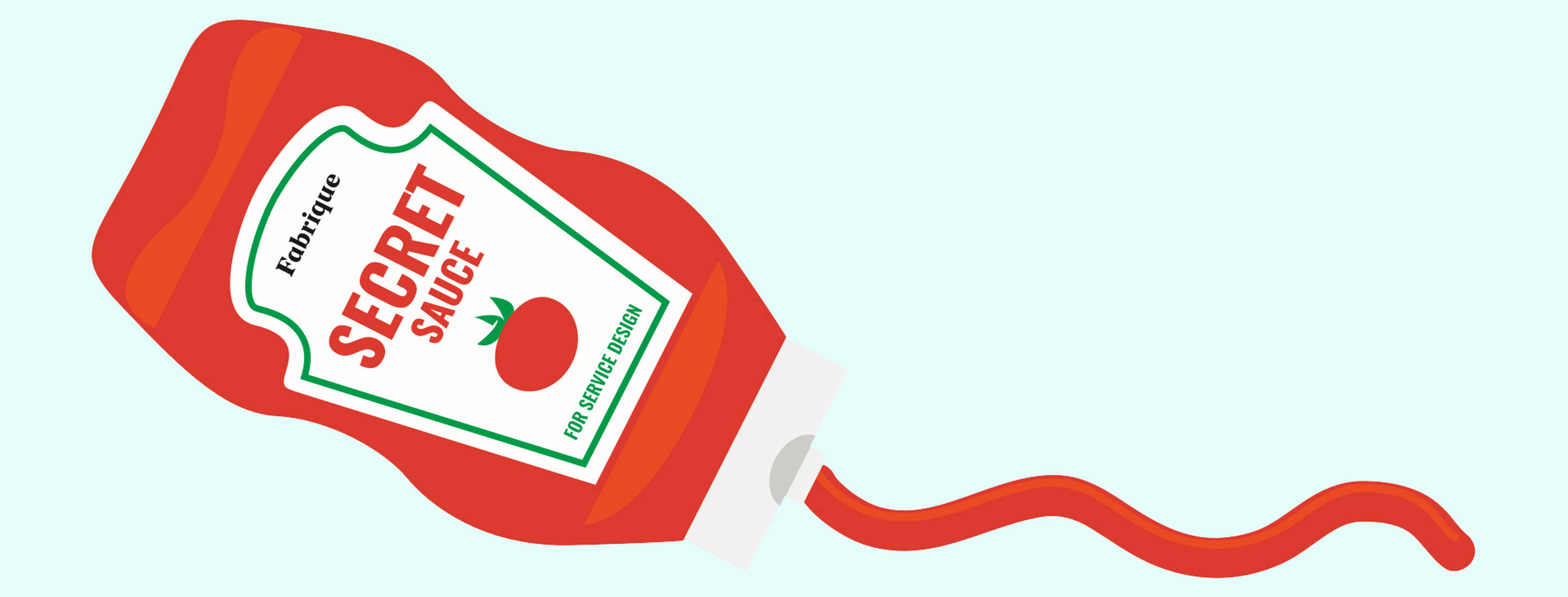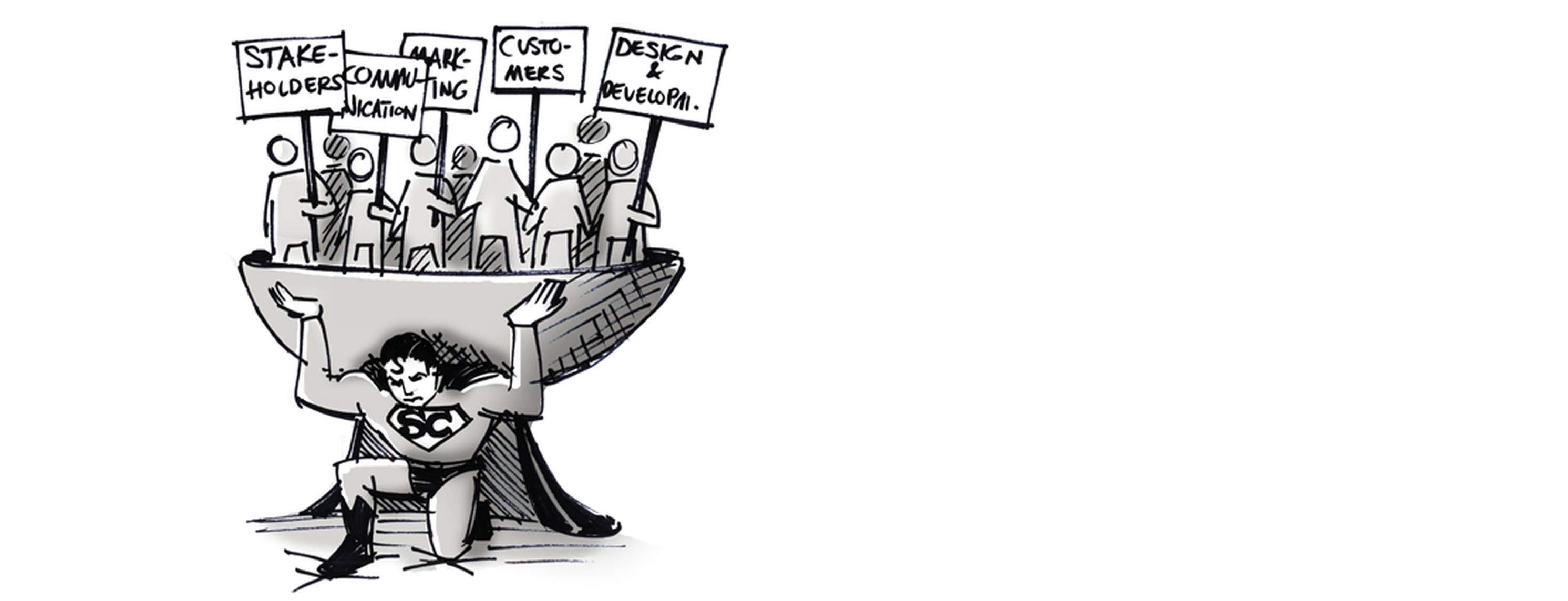Our secret sauce to Service design
In my previous blogpost, I wrote that Service design is made up of research, orchestration and organization. Even though that’s only three simple parts, Service design can still be very hard to do. Luckily we have found that there are three magic ingredients that make up a successful Service design endeavour. Our secret sauce is made up of:
- A strong service concept
- The designer mentality: curious, challenging, charming
- Oscillating point of view
If these ingredients are a bit exotic to you, no worries, I will tell you all about them!

A strong service concept
Every good service starts with a strong Service concept. If you can’t explain the service in one sentence, your endeavour is likely going to be a bumpy ride. However, if you can agree on the concept of the service from the start, it will help a lot in aligning everyone. Not just on the design of the touchpoints, but also on getting buy-in from your stakeholders.

We have learned the hard way that, without a clear concept, your project will lack a strong foundation and the team will go into different, possibly wasteful, directions. A strong concept not only propels the project, it also helps to promote and explain it to your customers once you go into the real world. Let me give you some examples.
If you can’t explain the service in one sentence, your endeavour is likely going to be a bumpy ride.
How would a news reporter describe your service?
Sometimes a simple metaphor can be a great way to explain the concept. For “HuisjeHuisje” Ymere came up with ‘Tinder for tenants’. Together we created an app for tenants who are looking for another house for rent. If users like each other’s house, they can meet in real life, and possibly swap houses.
Even when your service is not something that will be communicated or marketed, you still want to have a clear concept. Treat your service as a proposition: "The Largest Museum of The Netherlands is a service that creates a single museum experience out of 13 churches and synagogues across the Netherlands, with the help of location-based technology and high quality mobile content."
And have you heard about Dobbi, the Laundry as a Service. Dobbi’s service concept is exactly how a news reporter would describe it: “Dobbi picks up your dirty laundry and brings it back clean and folded in 48 hours”. Sure, there is a lot more to Dobbi, like the fact you need their app, you pay per kilogram of laundry and they can also dry clean and iron your clothes. But the basic concept is really simple and straightforward. Customers love simple and straightforward! Don’t worry about getting the wording of your service concept right on day one. You can tweak this as you go along, as long as everyone is behind it.
Leave the cap on your Sharpie, try to find the right words first
As a designer, you are often tempted to start sketching right away, because you have so many ideas that you want to visualize. That’s great, but at the same time, take a step back and try to make the concept concrete with just words, together. What’s great about words, is that they create the same level of fluency among your team and stakeholders. While designers are skilled visually, not all people are. However, everyone is trained to think in words.
The designer mentality
curious, challenging, charming
In our experience, the right mentality is just as important as knowledge of Service Design methods and techniques. Show you have curiosity and empathy, but also cheekiness and charm. With a good dose of stubbornness, because Service Design is often a matter of breaking through silos. It helps if you are not afraid to step on people’s toes now and then. Give and take. Demonstrate your complete desire to offer a great service to the user, one way or the other. If Road A is blocked, believe you will find Road B. Be persistent, but friendly.
Don’t be afraid to step on people’s toes now and then. It may hurt them a little, but they’ll thank you in the end.
Challenge the client, in a charming way
At a meeting, a colleague recently said to our client: “You are all little bees buzzing around in your own beehive, but it’s good to fly out now and then. We help you with an outside look.” Many people would find that hard to hear, but thanks to my colleague’s charm, it didn’t come across unfriendly at all.
Be the user in the room
Be the user when you are in a meeting with the client and stakeholders. If you are a passionate UX designer like we are, you can sincerely say that you are upset that the current user experience is just not good enough. “Do we want to do this to our user? I think this is not acceptable!” If the people in the room can tell that you are really standing up for the user, they will get behind you.
Be 360-degree empathic
That was the easy part right? As a designer, of course you have empathy for the user. But in fact, you should have empathy for everyone involved. Or as we say: be “360-degree emphatic”. Even if it seems that others have opposing interests. You will need everyone’s cooperation, so make different disciplines feel that you understand their expertise and their interests. Let the developer feel you get the technical limitations. Let the marketer know you understand the commercial side and show the brand manager you respect the corporate identity.
You will recognise this mechanism as a more human approach to the good old ''desirable, feasible, viable.''
Become an expert in the topic
If you dive into the topic, whether it’s law, e-commerce or healthcare, you will earn everyone’s respect. Be curious, sincerely want to learn from everyone involved and soak up all the jargon. It really helps if you can speak the other’s language. At the end of the project, the CEO of a legal company said to us: “your service designer can come work with us, he knows so much about our profession now!”
Oscillating point of view
Oscillating what? Yes, oscillating point of view. By that we mean the continuous switching between the ‘helicopter view’ and getting the details right. Up and down, like the graph on an oscillator. Because even though service design is about the orchestration of the whole experience, what often characterizes a great service is the attention to details. Great details can give the customer the feeling that the entire service is designed with care and deliberation. Take this delightful detail for example: one time, when I was replacing a full bag in my SimpleHuman garbage bin, I took out one of the last liners in the package and noticed this.

This put a smile on my face! Of course I can buy a different (cheaper) brand of liners, but those won’t fit as perfectly, and this small gesture has made me a loyal fan of SimpleHuman. Not coincidentally, they have an iPhone app to ‘subscribe’ to their liners, so you never run out.
Great details can give the customer the experience that the entire service is designed with care and deliberation.
So, designing the details can make a difference for you user’s experience. At the same time, climb aboard the helicopter often. If you have a strong concept and clear objectives, it should be easy to check if you are still on the right path. Does this feature really add value to our concept? Sure, it’s a cool feature, but is it necessary? Will this design detail make a difference for the overall experience? Is this the right spot in the customer journey to add a delighter, or is there another part that needs more delight? Will this extra touchpoint increase conversion? Or will it have little effect, other than burdening our customer with an extra touchpoint?
How do you do Service design?
Of course there are many different approaches to Service design. I have told you how we at Fabrique do it, but I’m eager to hear from you. What are your experiences with Service design? What works, what doesn’t? I look forward to reading your response!
Patrick Sanwikarja is UX Director at Fabrique, a strategic design agency, specialized in service design, innovation and brand development. His role is to guide companies and designers to work more user-centered.